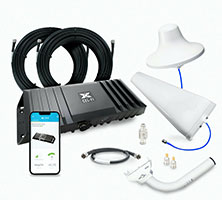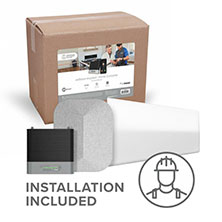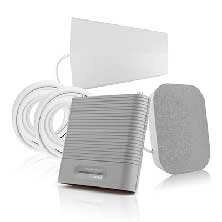How to Check Cell Signal Strength
Bars Do Not Reflect Signal Strength
As soon as we notice a drop in our cell reception, we instantly look at the bars on our iPhone or Android. While the bars on your phone are meant to visually show signal strength, they often vary between device manufacturers and models. Thus, they are not the most accurate way to check signal strength. Fortunately, there are more reliable methods.
Take advantage of our system design and installation services. Learn more or call us for a free consultation: 1-800-969-8189.
How to Test Signal Strength on Your Phone
Cell phone signal strength is measured in dBm (decibel-milliwatts). You may find many articles claiming signal strength is measured in dB (decibels), but that’s not entirely accurate. While dB and dBm are related, it's important to understand that:
- dB is a relative measurement indicating change (gain or loss) in signal strength without specifying an exact signal strength value.
- dBm is an absolute measurement, representing power level relative to 1 milliwatt, providing an exact signal strength value.
By finding your dBm reading, you can identify your true 5G and 4G LTE signal strength in your specific location. It will not fluctuate based on device manufacture or model. You can do this through Filed Test Mode, which can be found under your settings app on an Android or by typing in a code on an iPhone. It's essentially a diagnostic feature built into most phones that provides detailed information about your cellular network, including signal strength in dBm.
iPhone Field Test Mode
Finding dBm on iPhones varies across iOS versions, and it doesn't help that Apple constantly changes the layout of its Field Test Mode screen. In general, start by turning off your WiFi connection, and then follow these steps:
- Open phone app
- Dial *3001#12345#*
- Field test mode will open
- Look for your 5G and LTE RSRP values, which indicate dBm signal strength
For iPhone field test mode instructions by iOS version, click here.
Unfortunately, not every iPhone will provide RSRP measurements. This is because some carriers and chipsets are simply incompatible. The next best method is to run a speed test with your WiFi turned off. Speed results will give a more accurate picture of your cellular signal strength and the best coverage spots than bars alone.
Android Field Test Mode
Field test mode for Android devices varies by phone model and OS version, but it can usually be found under the Settings menu.
- Turn Off WiFi connection
- Tap “Settings”
- Tap “About Phone”
- Tap “Status Information” or “Network”
- Tap “SIM Card Status”
- dBm can be found under “Signal Strength”
There are also many signal strength test apps available. Some of our favorites include:
- Network Cell Info Lite (For Android): Features an easy-to-read signal strength meter that automatically starts working as soon as you open the app. It will also display the network and band you're connected to.
- weBoost App (For Android and Apple): Designed to simplify cell phone booster installations, it includes a user-friendly signal strength testing tool. It provides a signal meter for Android and step-by-step field test mode instructions for iPhones.
- Open Signal (For Android and Apple): While it does not measure dBm, it's a reliable speed test tool with various features for those who can't measure signal strength on their phone.
For more recommendations, visit our guide on Best Apps to Test Cell Phone Signal Strength.
What is a Good RSRP or dBm Wireless Signal Strength?
Cell signal strength typically ranges from -50 dBm to -120 dBm. Generally, a good RSRP or dBm reading is anything above -95 dBm. You'll notice dropped calls, failed texts, and slow data closer you get to -120 dBm.
Here is an estimated dBm signal strength breakdown (and their possible bar assignations, depending on carrier/phone manufacturer):
| Signal Strength | General Results |
| -50 to -79 dBm | Considered great signal (4 to 5 bars) |
| -80 to -89 dBm | Considered great signal (4 to 5 bars) |
| -90 to -99 dBm | Considered average signal (2 to 3 bars) |
| -100 to -109 dBm | Considered poor signal (1 to 2 bars) |
| -110 to -120 dBm | Considered very poor signal (0 to 1 bar) |
What Do I Do with My Signal Strength dBm Reading?
Now that you know how to find your cellular signal strength, the next step is to check your dBm in a specific location or throughout your home to identify the areas with the strongest and weakest coverage. Your dBm will fluctuate as you move around, but it may take a few seconds to refresh, so take your time and don't forget to keep notes.
With this information, you can easily determine the best spot for making calls, locate the general direction of your nearest cell towers, and confidently install a cell phone signal booster.
Hopefully, you can find a spot or two that are above -95 dBm!
How To Increase Mobile Signal Strength
Poor signal strength is often the result of cell tower distance, signal-blocking building materials, and physical obstruction. For a complete list, visit our guide on why your service is bad.
If your cell signal is not as strong as you'd like it to be, cell phone signal boosters help overcome those challenges to improve your connection and coverage. They take your existing outside cell signal (even if weak), amplify it, and rebroadcast it indoors. For more information, check out our article on How Cell Phone Boosters Work. Once installed, you'll experience fewer dropped calls, clearer voice quality, reliable messaging, faster data speeds, and extended battery life.
Here are our most popular units:

Nextivty Cel-Fi GO X

weBoost Installed Home Complete

weBoost Home Multiroom

SureCall Flare 3.0
For other home, vehicle, or commercial building options, take a look at our Best Cell Phone Boosters selection.
We specialize in consumer-friendly cellular booster kits as well as customized DAS solutions and WiFi for commercial applications. If you need help finding the right system for your specific needs, give us a call at 1-800-470-6777 or email us at sales@signalboosters.com.
FAQs
What's the Difference Between Signal Strength and Signal Quality?
Signal strength is how much signal your phone or other device is receiving. Signal quality is how much noise or interference that signal is contending with.
Radio signals are all around us from other cell towers, other calls, other devices, or even appliances. These signals can interfere with your cell phone connection to the tower. The more interference or noise there is, the lower your signal quality will be.
It is possible to have bad signal quality, and good signal strength or bad strength and good quality. Ideally, the two need to be good for clear calls and data. If you have good signal strength, but terrible quality, you will still experience dropped calls, slow data speeds, and breaks in voice.
What Does RSRP and RSSI Mean for Signal Strength?
RSRP stands for reference signal received power and is displayed in decibel milliwatts. It is the exact amount of signal being received by the device and is used to measure 4G/LTE and 5G. It takes an average of the power of the cell signals that your phone is getting from the tower and shows how strong those signals are. It will be shown on your phone as a dBm reading, between –110 and –50. The closer to –50 you are, the better your signal strength is.
Cellular routers for home or office internet, like the Peplink BR1 Mini and BR1 Pro 5G, also use RSRP measurements for signal strength. This can be found in the router’s interface, either in its app or in your browser. Check your router’s manual to find out how to access the interface.
RSSI or Received Signal Strength Indicator shows how strong a radio signal is. Your phone has an RSSI which shows up as the bars counter. RSSI is a baseline of how strong the signal is after cable and antenna loss. The stronger the RSSI, the stronger your signal is. RSSI is always shown in the negatives, so the closer it is it 0 the better your received signal is.
Interested in Learning More? Check Out Our Cellular Info Hub / WiFi Info Hub





